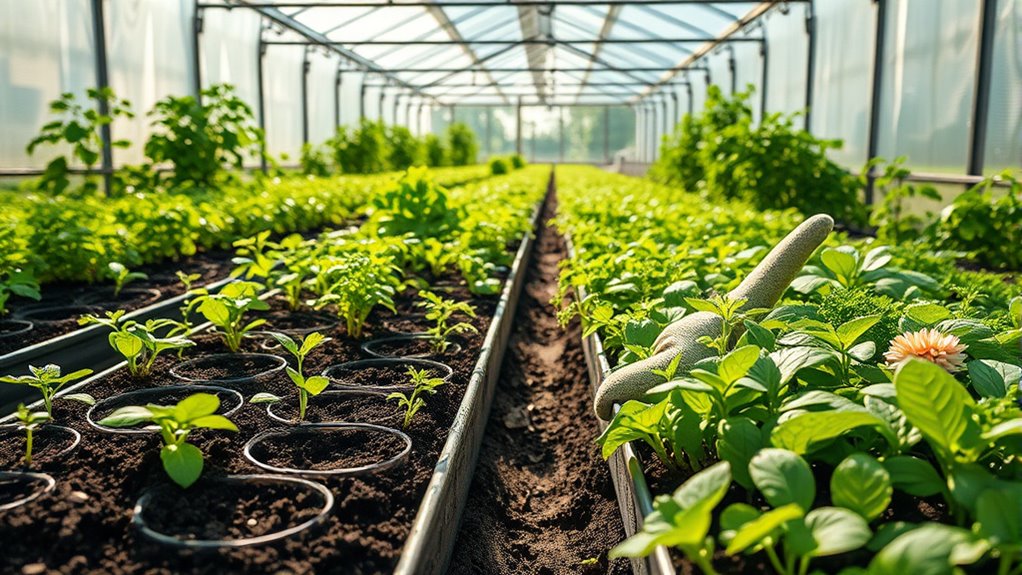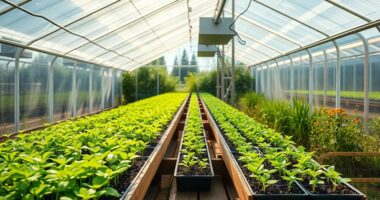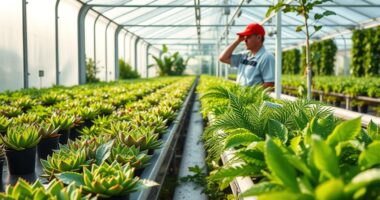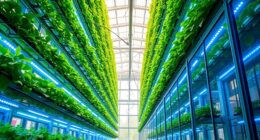Using organic fertilizers in your greenhouse boosts soil health, supports beneficial microbes, and provides natural nutrients for your plants. Apply compost or manure early in the season and supplement with liquid options like fish emulsion during active growth. Tailor your approach to your crops’ specific needs, monitor soil health with tests, and maintain a steady application schedule. Keep exploring how organic methods can create a thriving, sustainable environment; you’ll find more tips ahead.
Key Takeaways
- Apply compost or manure early in the season to naturally enrich soil before planting.
- Use organic liquid fertilizers like fish emulsion during active growth for quick nutrient uptake.
- Regularly conduct soil tests to identify deficiencies and tailor fertilizer application accordingly.
- Adjust fertilizer types and timing based on specific crop needs, such as leafy greens or fruiting plants.
- Maintain a consistent fertilization schedule to promote healthy plant development and sustainable soil health.
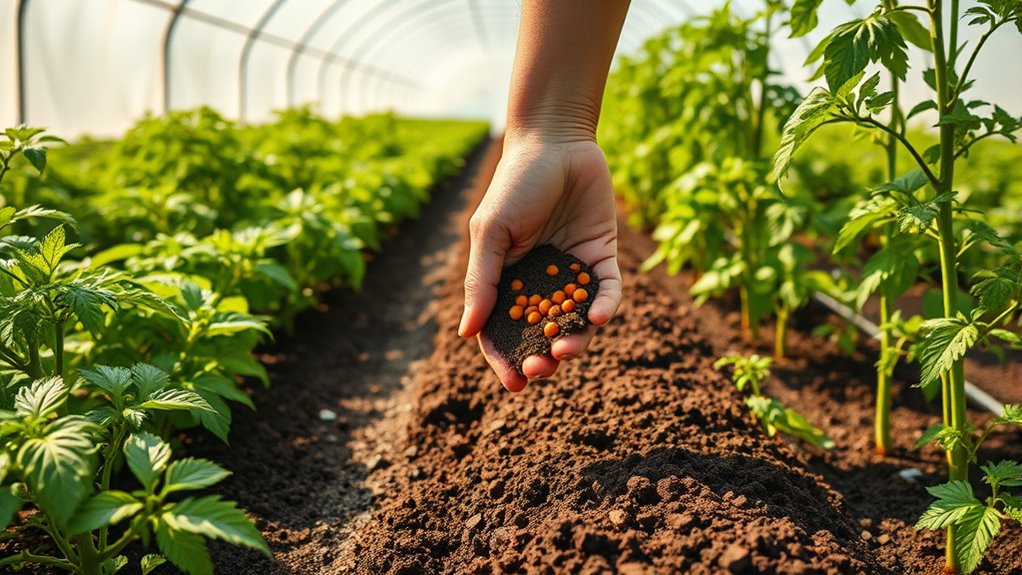
Have you ever wondered how to boost your greenhouse’s productivity naturally? The key lies in maintaining healthy soil and mastering fertilizer application. Organic fertilizers are a fantastic way to improve soil health, which directly influences the vigor of your plants. Unlike synthetic options, organic fertilizers enrich the soil with natural nutrients, fostering a thriving ecosystem beneath the surface. When you focus on soil health, you create a balanced environment where beneficial microbes flourish, breaking down organic matter into accessible nutrients for your plants. This process enhances soil structure, increases water retention, and reduces compaction, all of which contribute to healthier plant growth.
Using organic fertilizers effectively starts with understanding how and when to apply them. You want to guarantee your fertilizer application aligns with your plants’ needs and growth stages. For instance, applying compost or manure early in the season allows nutrients to integrate into the soil naturally, building a nutrient reservoir for later use. During active growth, supplemental organic options like fish emulsion or seaweed extracts can provide a quick nutrient boost without the risk of over-fertilization. Timing is vital—applying too much fertilizer too often can lead to nutrient imbalances or runoff, which can harm your plants and the environment. Instead, aim for a steady, consistent approach that supports your plants’ development.
Incorporating organic fertilizers into your routine also involves understanding the specific needs of your crops. Leafy greens may require different nutrient levels than fruiting plants like tomatoes or peppers. Regularly testing your soil helps you determine which nutrients are lacking and guides your fertilizer application. This targeted approach ensures you’re not wasting resources and that your plants receive what they need precisely when they need it. Additionally, organic fertilizers often improve soil fertility over time, creating a sustainable cycle of growth. As your soil becomes richer, you’ll notice better plant health, increased yields, and fewer pest or disease problems. Understanding soil health further enhances your ability to foster a thriving greenhouse environment.
Frequently Asked Questions
How Do Organic Fertilizers Affect Pest Populations in a Greenhouse?
Organic fertilizers can help with pest control by promoting healthy plant growth, which strengthens plants’ natural defenses. They encourage beneficial biological interactions that suppress pest populations naturally. You might see fewer pests over time because healthy plants attract helpful insects and microbes that keep harmful pests in check. So, using organic fertilizers supports a balanced ecosystem, reducing the need for chemical pest control and fostering a healthier greenhouse environment.
Can Organic Fertilizers Replace All Synthetic Nutrients in Greenhouse Gardening?
You might think organic fertilizers can fully replace synthetic nutrients, but the truth is more complex. Achieving perfect nutrient balance with organic options alone is tricky, and relying solely on them could threaten fertilizer sustainability. While organic fertilizers boost soil health, they often lack the immediate potency of synthetics. To guarantee ideal growth, blending both might be your best strategy, maintaining a sustainable, balanced approach to greenhouse gardening.
What Are the Best Organic Fertilizers for Hydroponic Greenhouse Systems?
You should choose organic fertilizers like fish emulsion, seaweed extract, and compost teas for your hydroponic greenhouse. These provide a good nutrient balance and support fertilizer stability, ensuring your plants get consistent, essential nutrients. Regularly monitor and adjust the application to maintain ideal levels. Organic options promote healthy growth while reducing synthetic dependency, making your system more sustainable and eco-friendly.
How Often Should Organic Fertilizers Be Reapplied in a Greenhouse Setting?
Imagine lush plants thriving while you monitor their needs—this is how often you should reapply organic fertilizers. In a greenhouse, you typically perform fertilizer application every 1-2 weeks, depending on plant growth and nutrient levels. Regular nutrient reapplication guarantees your plants get consistent nourishment, avoiding deficiencies or excesses. Keep a close eye on your plants, and adjust your fertilizer schedule accordingly to maintain healthy, vigorous growth.
Are There Any Risks of Organic Fertilizer Runoff Contaminating Greenhouse Environments?
Yes, organic fertilizer runoff can pose environmental risks and contaminate greenhouse environments if not managed appropriately. You should prioritize runoff management by using proper drainage systems and avoiding excess application. This helps prevent nutrient leaching into surrounding areas, protecting local ecosystems. Regular monitoring and adjusting fertilizer use ensure that your greenhouse remains environmentally responsible, minimizing the environmental impact while maintaining healthy plant growth.
Conclusion
As you tend to your greenhouse with organic fertilizers, you might notice tiny creatures thriving alongside your plants—a reminder that nature’s balance is always at work. Just like the first spring bloom that unexpectedly brightens your day, these natural nutrients foster healthy growth and vibrant life. When you nurture your greenhouse with care and organic matter, you create a harmonious space where abundance blooms naturally, making each harvest feel like a delightful coincidence born from your thoughtful effort.
